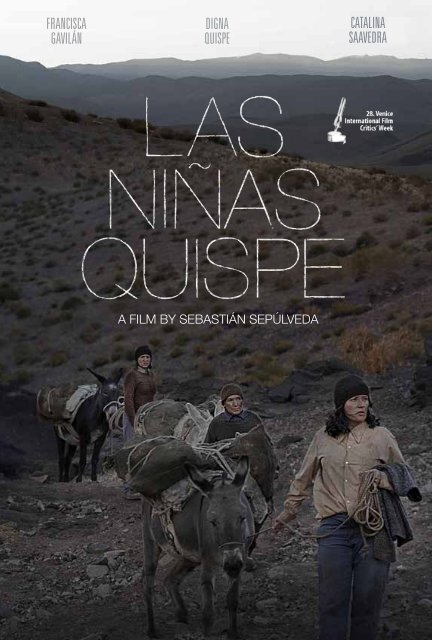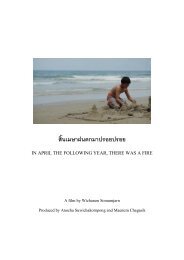francisca gavilán digna quispe catalina saavedra - Pascale Ramonda
francisca gavilán digna quispe catalina saavedra - Pascale Ramonda
francisca gavilán digna quispe catalina saavedra - Pascale Ramonda
You also want an ePaper? Increase the reach of your titles
YUMPU automatically turns print PDFs into web optimized ePapers that Google loves.
SynopsisBased on a true story that occurred in 1974, “The Quispe Girls” is thetale of the sisters Justa, Lucia and Luciana Quispe, shepherds in the Chileanaltiplano, who lead a solitary life. The recent death of a fourth sisterand news from abroad, forces the sisters to an existential quest that willrelentlessly bring them to a tragic end.
Director’s BiographySebastián SepúlvedaHaving spent 18 years living between Europe and South America, SebastiánSepúlveda returned to Chile in 1990 to study History. He laterstudied Editing at San Antonio de los Baños in Cuba and Screenplay atLa fémis in Paris. In addition to working as a screenwriter and editor, in2008 he directed the documentary “El Arenal”. “The Quispe Girls” is hisfirst feature.
Director’s NoteThe story of “The Quispe Girls” is a part of Chilean popular imagery.Based on a true event, it became a legend, like the legend of la Lloronain other parts of Latin America. What led me to want to make this film isthe dignity of Justa, Lucia and Luciana Quispe: three strong native Coyawomen faced with a threat from the outside. We shot the film in theplace where the Quispe sisters lived, 4000 meters above sea level, in thearid mountains of the altiplano. We documented their way of life: an asceticand primeval world, completely out of touch due to both its isolationand the period that Chile was going through. The spaces that we shot,all part of these shepherdess’ everyday life, are unique. The subjects thatthe plot touches upon –femininity in an austere world and the end of away of life— are, in my opinion, universal.
Interview with Sebastián SepúlvedaRegarding the project’s origins: why film this story? What interestedyou at first? Was the fact that it takes place in 1974 significant, seeingas you were a child back then?What first interested me was that the story takes place in a primeval world, a statethat has to do with the essential matters of human beings. The central story toucheson subjects as basic as the end of the world, the end of the way of life that the Quispesisters understood as existence. Starting from this foundation, the project was veryinteresting to me. Now, I don’t think that films can be reduced to only a couple of subjects;they are a meander of subjects, interconnected images, words, and spaces thatcreate, in the best of cases, living worlds in movement for the spectator.
The fact that the story happened in 1974, during Pinochet’s dictatorship, wasalmost more complicated. Since my parents were exiled, the subject of thedictatorship was an everyday thing during my childhood. It was spoken of overbreakfast, and it is a subject that I’ve always been reluctant to touch: you couldsay I had antibodies. I found that it was interesting to talk about it but from adifferent place, from a different culture and from the absolute fringe. The dictatorshipis something that arrives to the Quispe sisters as an echo of a farawayworld, not as something tangible and everyday in their lives. Life under thedictatorship is information that arrives from the distant world of the city, andwhich in the gigantic space that is the altiplano desert, takes on other formsand becomes a nightmare. From this point of view, the subject was approachableto me.How did you carry out the investigation? In what way did you approachthe shooting, the casting?The story is based on true events, and this is why I decided to go and livein the mountains for two months with one of the last coya families of thecommunity that the Quispe sisters belonged to. This was done, above all, inorder to hear the stories and gain a better understanding of their imagery,and not really to search for a verism, which I wasn’t interested in. I knewthat I wanted to shoot a fiction film and not a purist documentary.I was interested in documenting the spaces, the “rucas”, this is, the cavesor huts that coya shepherds build in the mountains to live in for a fewmonths during the summer. They were surprising to me, and I felt that Ihad to leave a visual testimony of them. All the rucas that can be seen inthe film were built by coya shepherds, and the place in which the Quispesisters live in the film is the last ruca that they actually lived in. The rockwhere they carry out their final ritual was the same rock that the Quispesisters chose.I shot the film with a small team of eleven people, because I felt that morepeople might “invade” these spaces with their walkie-talkies and all of thegear that more industrial film entails. I also did this so that the non-actorswho act in the film, who belong to the last two families that live in theplace, would feel less invaded and calmer in their natural environment.In the case of the elder sister’s character, Justa, I chose Digna Quispe, whomI met while scouting locations. Digna is the Quispe sisters’ niece, and the lastperson who saw them alive. But I chose her mostly because I made a screentest with her in the mountains, during a small break that she took between herchores with the animals, and I liked the way she acted. But later, during theshooting, she surprised us all with her tremendous acting level.At first, I thought about working exclusively with non-actors, but soon dismissedthe idea. First of all, because there is practically no one left in this place.The film speaks of the depopulation of a space, and this is what happened. Andin general, in films that are made with non-actors, especially if they belong toa different culture, a relationship, a vertical perspective tends to take place. Igreatly admire Pasolini, who mixed actors and non-actors and took it to a poeticspace that had a reality of its own. My idea was for the actors to contributetheir technique to the drama’s interpretation and for the non-actors to bring inthe tone, the documentation of a way of life. In some way, I always thought ofit as a graft, with a dialogue that could deliver its own representation of thisstory. Catalina Saavedra and Pancha Gavilán are two tremendous Chilean filmactresses who adapted to the place’s rough conditions and to working with theanimals. Working with them was a privilege.These women are like foreigners in their own country, far away frominhabited places. Is this something that you intended to delve into: isolation,rural areas?More than isolation, what I was interested in delving into was the fact thatthey lived in a different cultural time than that of the city, which is Chilean andtherefore occidental, as well as under a dictatorship. The dictatorship broughtalong with it the idea of a new order: the modernization of business, rationalization,to safeguard the erosion of wages produced by the animals, and therefore,conducive to the prohibition of their shepherding. It also brought along theprohibition of dynamite possession for small miners out of fear of acts againstthe government. This ended up depopulating the mountains completely. And onthe other hand is the life of these shepherdesses, with an ancestral culture inwhich animals form a vital part of their lives, just like the mountains, the rocks.These two times, which do not know how to dialogue, that are unable to findand understand each other, are what interests me.
DirectorSebastián SepúlvedaProducersJuan de Dios LarraínPablo LarraínScreenplaySebastián SepúlvedaAn adaptation from the play“Las Brutas”, by Juan RadrigánCo ProducersMarc IrmerDiego Urgoiti-MoinotFernando SokolowiczCinematographyInti BrionesProduction DesignerCristián MayorgaCostume DesignerMuriel ParraLine ProducerRuth OrellanaAssistant DirectorOscar GodoyFilm EditorSantiago OtheguyPost ProducerCristián EcheverríaExecutive ProducersJuan Ignacio CorreaMariane HartardRocío JadueAndrea Carrasco StuvenClara SzwarcCastDigna QuispeCatalina SaavedraFrancisca GavilánCountriesChile / France / ArgentinaProduction CompanyFabula (Chile)Co Producer CompaniesDolce Vita Films (France)Cinema Uno (Argentina)LanguageSpanishShooting FormatDigital HDScreening FormatDCP, Color, 2.39 ScopeSoundDolby SR 5.1Runtime80 min.Year2013
CONTACT DETAILSWorld Sales / SWIPE FILMSFrank Mannion – Sales & AcquisitionsCell: +44 7887 954 005frank@swipefilms.comSWIPE FILMS151 King Henry’s RoadNW33RD London – United KingdomTel: +33 1 401 305 86enquiry@swipefilms.comwww.swipefilms.comPRODUCTION COMPANY / FABULAJuan de Dios Larraín - Producerjuandedios@fabula.clJuan Ignacio Correa – Executive ProducerCell : +56 9 952 853 68juanignacio@fabula.clFABULAHolanda 3017, Ñuñoa7770057 Santiago - ChileTel: +56 2 2344 09 08contacto@fabula.clwww.fabula.cl



